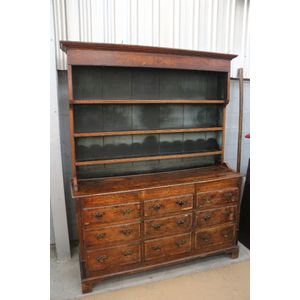English Oak Welsh Dresser with Crossbanded Drawer Front
18th century English oak elm & walnut Welsh dresser with crossbanded drawer front, 160 cm (W) x 51 cm (D) x 200 cm (H)
You must be a subscriber, and be logged in to view price and dealer details.
Subscribe Now to view actual auction price for this item
When you subscribe, you have the option of setting the currency in which to display prices to $Au, $US, $NZ or Stg.
This item has been sold, and the description, image and price are for reference purposes only.
- Oak - Native to Europe and England, oak has been used for joinery, furniture and building since the beginning of the medieval civilisation. It is a pale yellow in colour when freshly cut and darkens with age to a mid brown colour.
Oak as a furniture timber was superceded by walnut in the 17th century, and in the 18th century by mahogany,
Semi-fossilised bog oak is black in colour, and is found in peat bogs where the trees have fallen and been preserved from decay by the bog. It is used for jewellery and small carved trinkets.
Pollard oak is taken from an oak that has been regularly pollarded, that is the upper branches have been removed at the top of the trunk, result that new branches would appear, and over time the top would become ball-like. . When harvested and sawn, the timber displays a continuous surface of knotty circles. The timber was scarce and expensive and was used in more expensive pieces of furniture in the Regency and Victorian periods. - Crossbanding - Crossbanding is a decorative technique used in furniture-making, where thin strips of wood, known as crossbands, are applied to the surface of a piece of furniture to create a decorative border or inlay. The crossbands are typically made of a different type of wood or a different color than the main piece of furniture, and are applied in a geometric pattern, such as a checkerboard or herringbone design.
Crossbanding was a popular decorative technique in furniture-making from the 17th to the 19th centuries, particularly in the Baroque, Rococo, and Chippendale styles. It was often used to create intricate patterns and designs on the surfaces of tables, desks, cabinets, and other pieces of furniture. The crossbands were often made of exotic woods, such as ebony or rosewood, which were imported from other parts of the world and were highly prized for their rich colors and patterns.
This item has been included into following indexes:
Visually similar items

19th century cedar kitchen dresser with two doors & two drawers in base
Sold by
in
for
You can display prices in $Au, $US, $NZ or Stg.

Immitation Cartier du Must, ladies wrist watch
Sold by
in
for
You can display prices in $Au, $US, $NZ or Stg.

Japanese carved ivory figure of a Geisha
Sold by
in
for
You can display prices in $Au, $US, $NZ or Stg.

A piece on natural coral, height 10 cm
Sold by
in
for
You can display prices in $Au, $US, $NZ or Stg.
